
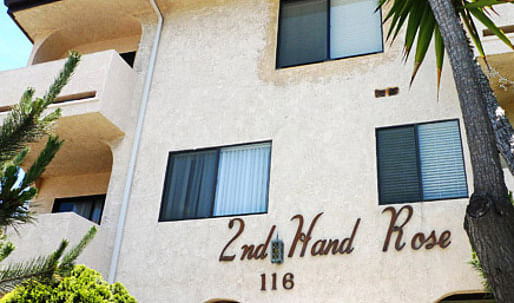
Sitting in my architectural ‘writing studio’ thinking that I have nothing to say, no books to write, no gossipy quarters to spread the word, no invitations from prestigious magazines who publish noteworthy architectural projects and noteworthy opinion pieces written by noteworthy socialites. I am feeling distant to architectural intelligentsia, to the blogs of buzzing architectural pornography and utopia du jour of high thinking. I say; “Buzz this!” At least I have ideas, freedom and a point of view from my car.
As we were discussing a situation with my neighbor Joey Luna in unit G, I did say this, "all those dreams arrive in Los Angeles from distant places, dissipate into the thin walls of the dingbat apartments."
by Orhan Ayyüce
Earlier on, these boxy two story residential structures were the pride of ownership buildings, providing housing which were affordable, stylish and comfortable for the increasing population of Los Angeles. They were successful as single family dwelling replacements responding to demand of booming post war workforce and migration. They were human and they were worthy of some minor fantasies and California dreaming. If you were the owner, they were great as income properties, making you feel like a Conte or in English, the nobleman style Count entitled to first month's rent and last month's deposit. They could be called stucco retirement fund.
They are everywhere in Los Angeles. Looking for them is like looking for a hay in a haystack .
There are 50 & 60's originals, 70's diagonal wood siders, 80's transition style, 90's high stacks with vinyl mullion windows, and of course now, all ubiquitous walls of glass (curtains drawn) clean liners, and so on. You can make your own list.
If you have not lived in a dingbat apartment, you are not an Angelino yet.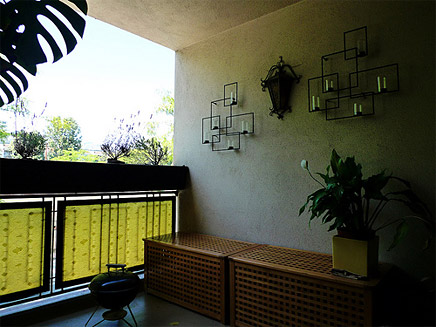
ROSE
Sometime in the mid sixties Jack sent this note to Rose; "Honey, I do love you and the building is yours, but I won't divorce my wife and lose everything."
From that day on, Jack's pin-up girl was the front unit owner occupier, living the apartment life, having affairs with his friends and having jurisdiction over the units in the building which she named 'Second Hand Rose,' just to make Jack forever jealous and feel guilty.
After throwing the property her way to save his other and more valuable holdings from a nasty divorce, he moved on, increasingly distancing himself to pursue his political ambitions to become a neighborhood councilman. He never made it in politics. Suffering from Alzheimer, called his wife 'Rose' for the last two years of his life and eventually died from an heart attack in his backyard in Whittier.
As we were smoking cigarettes in the laundry room by the alley, Joey and I were told by downstairs Cindy that Rose has quietly died this morning at the care home. And, what's more, unit F Sandy's new biker guy boyfriend who sometimes stayed over on weekends, cooking cheap steaks on a hibachi and drinking Coors Light with her, was a suspect of running away with all the jewelry from Rose's apartment. Son of a bitch. I never liked him.
Now that Rose is gone, I instantly thought of moving somewhere else. Since she was taken to a nursing home three weeks ago, the place already lost all its charm and color.
Without her, I wasn't going to be able to live half the rent in exchange for compiling her memoirs. In her diaries she would go on and on about Jack and why she was a better woman than his wife and page after page about their trip to New York and staying at the Waldorf Astoria and seeing the Broadway show, the King and I and in their room doing the same dance they saw in the show.
Even though Rose knew Jack was more of a buffet man, that time in New York, she thought of him as bold as Yul Brynner to fulfill her own fantasies.
Rose liked having me around even though I never really did much with her stories except read them back to her out loud and turning them into computer files for the book that was too long already.
A lot of Rose's stories dissipated into those walls.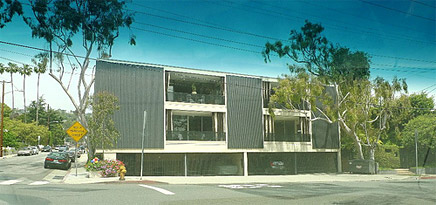
In his book titled, 'Glitter Stucco and Dumpster Diving: Reflections on Building Production in the Vernacular City,' Los Angeles urban planner and historian John Chase, with John Beach, summed up the background of dingbat apartments in the opening essay, 'the Stucco Box,' I quote:
"The stucco-surfaced speculative apartment house is a symbol, for good or ill, of that golden age of Los Angeles, the 1950s. It was a time when Southern California seemed to come into its own, as a place where social and economic mobility combined with a benign climate to create a mythic good life, accessible, it seemed, to almost everyone. The stucco box apartment house reflected at once the pragmatic and hedonistic character of Southern California.
It was ruthlessly expedient, made out of cheapest materials, by the simplest construction methods, allowing a maximum number of units to be shoehorned into a single lot. At the same time, these buildings were glamorously packaged consumer objects that often permitted more contact with the outdoors, easier access to the auto and greater recreational opportunities than had Los Angeles' earlier tenement-style apartment houses. Some stucco boxes were more daringly abstract and more completely modernistic than others."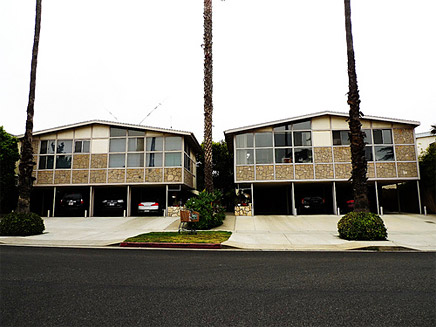
FRONT UNIT CASE : A random cross section of the apart-mental life.
As much as Samantha didn't like Steve across her front unit apartment identical to hers, they had an unspoken agreement not to go public about what they knew about each other's lives.
Steve's unrelenting attraction for her was never to be answered in kind.
Except that day, after the ever humbling earthquake, he invited her for a pasta dish that he perfected in his all clean bachelor's kitchen. She, in a moment of hesitation said yes.
It is necessary to mention here that they had one common friend, Ronny the designer/decorator who mixed and matched interesting gossipy details and played both sides as long as they paid her for occasional services.
He already knew, from Ronny, that she liked to listen Lynyrd Skynyrd's Freebird during sexual climax for some reason and Steve practiced having sex with her on the mail ordered inflatable doll.
As the song went, nothing could change for either one of them, living in the same place since '69 and now forty some years later, looking older but still paying next to nothing for the rent controlled beautiful front unit apartments North of Wilshire in Santa Monica.
As those years passed and Steve's fettuccine Alfredo was improved but Samantha could no longer have dairy products absolutely necessary for his recipe.
That night she brought the left over office party Chablis in a cardboard container and he had to change the main ingredient of his pride and joy cream sauce with soy milk.
Nothing happened after the uncomfortable and botched dinner encounter.
She left early, Steve reflected, that he was going to die a lonely man, put Freebird on the CD player and start to blow air into the doll.
Sammy called me that night to come to her unit and listen to some 70's rock 'n roll music, I told her I was working on the Second Hand Rose story that I managed to sell to a TV producer living in the newly built loft style South of Montana Ave. condominium with a chance to go 'pilot' next year.
I could not fuck that up, I declined.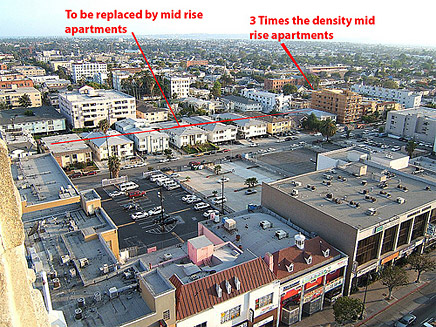
V.2 STYLE, Sky is the limit. Let's get critical for a minute.
The Dingbats were the first version of discount modernism in Los Angeles. The secretaries, bookkeepers, limo drivers, students, starlets, retirees were all covered by the flat roofs of these beauties. Upstairs or downstairs, they were all affordable, democratic, noisy.
These buildings eventually suffered from the same thing they themselves liked; the automobile speed. The architects never stopped long enough to look at them. The dingbats represented the opposite of everything they were supposed to design.
Their best aspects were overlooked by big money developers busy with disproportionate profits and rapid gentrification bringing in homogeneous groups in new housing.
All this, eventually leading to the displacement of dingbats' best friends: lower income people, credit problematic, paycheck cashing types, menial working class, people trying to stay afloat, in general.
By the time most municipalities incorporated new regulations to shape the next type of apartments, the stakes were higher and keys were given to upper income people who knew what excellent credit rating meant and could maintain their lives that way.
The manager in the back unit was replaced by the luxury SUV driving leasing agents who showed the 'property' above the popular new restaurant .
The new version of dingbats are AIA awarded, taller and incorporate more money.
Not always rental, owner occupied units take on today's commodity minimalism style as they accommodate people with some exposure to magazine advertised life and dwelling styles within their reach.
In short, newly built housing stock are more about upwardly mobile groups than we are all in this city together mind set. It is because, this is our omni-lasting economic improvement model for real estate, and, on a larger scale, of urban development.
Projectively speaking, Los Angeles' need for new housing stock presents endless potential for architects and urban designers as they reflect on something more sweeping and apparent. Densification . The inescapable cause that can also necessitate urban transformation and creative possibilities, transportive, generative and other infrastructural changes.
As Los Angeles grows up another allowable story or more, it also proves most of its building stock are not too precious. The city of cars can proceed with what many older major cities in the developed world can't do; increase housing units in its center in doubling or tripling percentages. If this is reinforced with liberating the zoning conditions, it can lead to most spatially visible urban change since the freeways.
This is the significance of the search for newer versions of housing.
But, until it is energized by new economic innovations and models enabling lower income groups in ownership or providing affordable rents that are realistically proportioned and paired with general income distribution, the new fortress like model mostly flexes muscle on the exclusivity for the financially secure. Its privileged high pricing and discriminating qualifications for the target occupants, paints the economic sustainability of this current built for the hi-end market housing typology worrisome and unavailable for the actual majority of the city, lower income urban dweller.
When the working class people (add popular symbolism here!) and their communities excluded and pushed out from the urban neighborhoods, the healthy and colorful diversity of the city is compromised.
That would lead to many ills and put a lid on the sustainable and accessible urban developments in general. This condition is important to consider in any design attempt for 21st century housing and the make up of the cities.
Posthumously dedicated to John Chase, Rest in Peace, August 13, 2010
Orhan Ayyuce
RELATED REVIEW: the Dingbats 2.0 exhibition opening in Los Angeles, June 19.
Great exhibition with provocative ideas for possible new housing scenerios. A must see.
Info: Los Angeles Forum for Architecture and Urban Design
(Left) My favorite competition exhibition
(Center) My favorite Audience at the opening
(Right) My favorite selection from the exhibited designs entries
(click to enlarge)


Creative Commons License
This work is licensed under a Creative Commons License .
/Creative Commons License
A long-time contributor to Archinect as a senior editor and writing about architecture, urbanism, people, politics, arts, and culture. The featured articles, interviews, news posts, activism, and provocations are published here and on other websites and media. A licensed architect in ...
13 Comments
I thoroughly enjoyed reading that. Great stories in between - evocative.
One question: isn't the "soft story" with ground level parking terrible in earthquakes? Have dingbats tended to collapse more than other forms of apartment buildings?
Orhan interesting read on a unique LA typology. It would be interesting to see if this phenomenon has been translated to other places
Donna,
Earthquakes?
I think yes. But the real disasters were the 3 and 4 level apartment complexes. They pancaked in the earthquake. My mother lived in a 2-story dingbat and during the big quake all the larger apartments fronting her street near Ventura Blvd in Sherman Oaks were quite damaged. Hers stood.
I think that Orhan's piece deserves more discussion because I like it and because it introduces a different kind of writing to Archinect's typical discourse.
This is a hybrid writing form of subjective criticism and fiction narrative. The piece expands the way to approach looking at architecture writing to include both the personal and the objective. I like the approach because it wraps other types of discourse within the critical observation. I like this because it has potential to open up our own discussions about architecture to include the personal, the tangent, the wanderlust of writing. After all, are not architects a bit more sensitive to nuance in design. This piece doesn't pretend to be objective, but it does attempt to make art. And I appreciate the effort and applaud the work. Thanks Orhan.
eric chavkin
thank you donna, architechnophilia and eric.
i do find most architectural writing accessorial to an already accomplished object, ie; an architectural project, building, an object or as such. this is the crux of most writing about architecture. it mostly goes to where the object went and it rarely ventures further away. basically it is a piggy back ride. this is what we are accustomed to expect from architectural text. often the use of 'narrative' in architecture is a bogus description.
in many cases, architects hardly narrate anything but love the use of the word narrative, literally and structurally. there is nothing confuses me more than many words next to an architectural drawings to gain depth to otherwise empty project often to the detriment.
the other day i saw a student project with no text whatsoever. wow, what a refreshing panel that was. even though i know she did it for other reasons.
if the text only used to force or rationalize the existing object, then it becomes a parasitical collection of words, sentences, an additional veneer on the object itself..
this is what i am trying to break away from, generate personal and everyday experiences from buildings on top of their physical existence or planning process.
architects have tendency to see everything they design as a prototype, something that is going to change the way we live and the way we design. always the idealized.
i am more into 'okay, now you have this building.., what happens in it? where does it go? who are they and do they carry guns? what do they believe in?' approach. i pose this questions sometimes as crude and sometimes more refined ways.
you are right, i do objectify the piece itself, play with different forms, timing, scale etc.. but naturally, that is the creative section of my experience..
Great article, nice responses and bonus points for mentioning John Chase. We don't often pay enough attention to life itself to make responsive containers and stages for our considered (or ill-considered) craziness. In "Second Generation" Esther McCoy compares a morning spent with the lucky occupants of a Ain (or Davidson?) house with a scene from a Chekov play. Much more evocative than describing the furniture.
Glad for her it wasn't Ibsen...
Orhan, is he the same Joey Luna who stole your color TV and brought back his grandmother's b&w after feeling sorry for you....? :)
I agree with above posters. As before, great and creative way of writing about urban life and physical space. Really refreshing for architectural writing and fun to read. Yes, the hybrid is beautiful. As the tone, I get the slight overcast which is very appropriate and your usual reductive style moves like the fluid. Very artful.
OPed
There a book lying in waiting here.
thanks again. maybe i scare the publishers or rub them the wrong way.;.) i need the right people to publish with, i love archinect for my work the best. cameron sinclair called me insurgent!.;.)))
Posthumously added a dedication to john chase at the end of the article.
Orhan, thank you for your honesty I really liked the piece. This is Emmanuel from Cal Poly Pomona, I hope you remember me. I'm surfing the web and local library to find out what I want to do for my senior project. I've been thinking about housing, urban housing and all its implications. Densification of the city. I found in your article inspiration. LA is a very interesting city. The more I know about it, the more I want to stick around. I hope to see you soon. Thank you for your guidance. Take care.
Was checking out the response to comment link and saw the news here about John Chase. Very good of you to add the dedication. Orhan, the torch has been passed. Along with DJ Waldie I think your writing is among the best writing about this crazy LA light. Thanks!
but of course eman, why wouldn't i remember you.;.) i think you are on to something for your senior project. i'll probably see you next month in school and we can talk more about it.. thank you for your words..
-------
archikvetch, thank you. we need at least two dozen more jc's here in LA to get it going.;.)) he was very inspiring to us all.
Block this user
Are you sure you want to block this user and hide all related comments throughout the site?
Archinect
This is your first comment on Archinect. Your comment will be visible once approved.